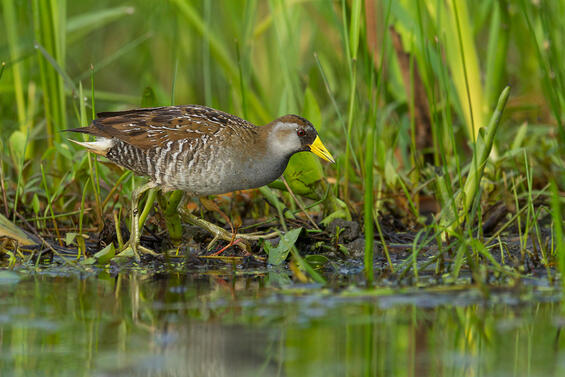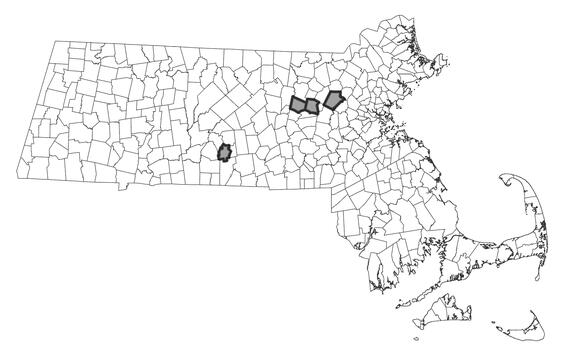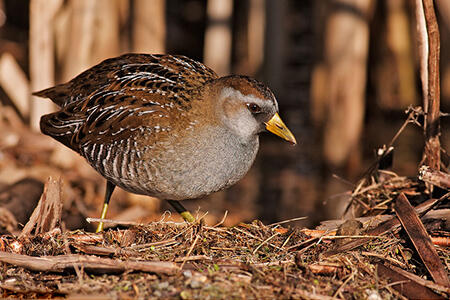- Scientific name: Porzana carolina
Species of Greatest Conservation Need (MA State Wildlife Action Plan)
Description
The sora is a small, plump, gray-brown rail (20-25 cm [8-9.75 in] in length). The sora has large feet, a short tail, and a short yellow bill. Adults have a distinctive black patch on the face and throat. Because of its secretive habits, this species is more often heard than seen. Calls include a loud descending whinny, a plaintive whistled ker-wee, and a sharp keek.

Sora (Porzana carolina)
Life cycle and behavior
Soras typically arrive to their breeding grounds in Massachusetts by mid-to-late-April. Pairs are monogamous for at the breeding season and vigorously defend their territories against other soras. Soras are very secretive and seldom seen. Their primary diet is the seeds of aquatic plants, supplemented by invertebrates.
Population status
Sora is a Species of Greatest Conservation Need in Massachusetts.
Distribution and abundance
The sora is a rare breeding species in Massachusetts, nesting at widely scattered wetlands where suitable habitat occurs. A statewide survey of marsh birds during May, June, and early July in 1991-93 found soras in only 30 of 177 wetlands surveyed and estimated that most wetlands supported only 1 or 2 pairs.

Distribution in Massachusetts. 1999-2024. Based on records in the Natural Heritage Database.
Habitat
In Massachusetts, the sora breeds primarily in freshwater marshes dominated by cattails with good interspersion of other emergent, floating-leaved, and submergent vegetation and open water. It is also found in wet meadows in late summer and early fall, and in salt marshes during migration. Soras are attracted to patches of wild rice in late summer and early fall.
Healthy habitats are vital for supporting native wildlife and plants. Explore habitats and learn about conservation and restoration in Massachusetts.

Threats
Invasion of wetlands by Phragmites are the primary modern threat to breeding soras in Massachusetts.
Conservation
Maintaining integrity in breeding wetlands is key; especially controlling invasive species. Soras are also sensitive to disturbance, and therefore all development should be sited away from breeding areas and the use of machinery should be avoided around breeding sites during the breeding season.
References
Melvin, S.M., and J.P. Gibbs. “sora (Porzana carolina).” 1996. The Birds of North America, No. 250 (A. Poole and F. Gill, eds.). Academy of Natural Sciences, Philadelphia, PA, and American Ornithologists’ Union, Washington, D.C.
Petersen, W.R., and W.R. Meservey. Massachusetts Breeding Bird Atlas. Amherst, MA: Massachusetts Audubon Society and University of Massachusetts Press, 2003.
Veit, R., and W.R. Petersen. Birds of Massachusetts. Lincoln, MA: Massachusetts Audubon Society, 1993.
Contact
| Date published: | April 4, 2025 |
|---|